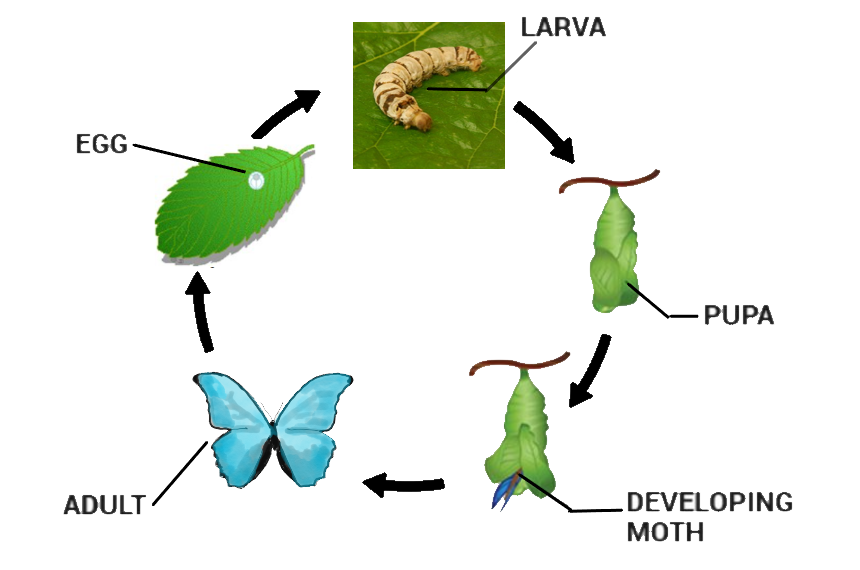
Name the life cycle of a silk moth in cyclic form.
Answer
464.4k+ views
Hint: Sericulture is the process of breeding silkworms for the production of raw silk. The duration of the life-cycle of a Silkworm ranges from 6-8 weeks. Silk moth shows complete metamorphosis which comprises five stages.
Complete answer:
Silk moth
- Its scientific name is Bombyx mori.
- It is an insect and belongs to the moth family Bombycidae.
- The duration of the life-cycle of a Silkworm ranges from 6-8 weeks.
- The warmer the weather, the faster the Silkworm will complete its life-cycle. The other factors are also important like humidity and exposure to sunlight.
- Life cycle of silk moth is divided into following stages:
> Egg
Copulation between male and female silkworm moths lasts for several hours and during this period moths do not eat or drink. After mating, the female silkworm moth lays tiny eggs on mulberry leaves. After laying eggs, the adult moths die.
> Larva or caterpillar stage
During this stage the silk moth will go through four molts before developing into pupa. The periods between molts are termed as silkworm instars.
> Pupa
After they have molted four times, their bodies become slightly yellow, and the skin becomes tighter to enter the pupa phase of their lifecycle. They enclose themselves in a cocoon made up of raw silk produced by the salivary glands. The final molt from larva to pupa takes place within the cocoon, which provides protection during the vulnerable, motionless pupal state of the silk moth.
> Adult Silkworm
In this final stage when, the pupa changes into an adult moth. The male moth is smaller than the female. The female moth releases pheromones to attract male moths. The male moth has longer antennae to detect pheromones from a distance. When the two find each other, they copulate and the life cycle begins again.

Note: Copulation between male and female silkworm moths lasts for several hours and during this period moths do not eat or drink. The male moth has longer antennae to detect pheromones from a distance.
Complete answer:
Silk moth
- Its scientific name is Bombyx mori.
- It is an insect and belongs to the moth family Bombycidae.
- The duration of the life-cycle of a Silkworm ranges from 6-8 weeks.
- The warmer the weather, the faster the Silkworm will complete its life-cycle. The other factors are also important like humidity and exposure to sunlight.
- Life cycle of silk moth is divided into following stages:
> Egg
Copulation between male and female silkworm moths lasts for several hours and during this period moths do not eat or drink. After mating, the female silkworm moth lays tiny eggs on mulberry leaves. After laying eggs, the adult moths die.
> Larva or caterpillar stage
During this stage the silk moth will go through four molts before developing into pupa. The periods between molts are termed as silkworm instars.
> Pupa
After they have molted four times, their bodies become slightly yellow, and the skin becomes tighter to enter the pupa phase of their lifecycle. They enclose themselves in a cocoon made up of raw silk produced by the salivary glands. The final molt from larva to pupa takes place within the cocoon, which provides protection during the vulnerable, motionless pupal state of the silk moth.
> Adult Silkworm
In this final stage when, the pupa changes into an adult moth. The male moth is smaller than the female. The female moth releases pheromones to attract male moths. The male moth has longer antennae to detect pheromones from a distance. When the two find each other, they copulate and the life cycle begins again.

Note: Copulation between male and female silkworm moths lasts for several hours and during this period moths do not eat or drink. The male moth has longer antennae to detect pheromones from a distance.
Recently Updated Pages
One difference between a Formal Letter and an informal class null english null

Can anyone list 10 advantages and disadvantages of friction

What are the Components of Financial System?

How do you arrange NH4 + BF3 H2O C2H2 in increasing class 11 chemistry CBSE

Is H mCT and q mCT the same thing If so which is more class 11 chemistry CBSE

What are the possible quantum number for the last outermost class 11 chemistry CBSE

Trending doubts
10 examples of friction in our daily life

Difference Between Prokaryotic Cells and Eukaryotic Cells

What is the specific heat capacity of ice water and class 11 physics CBSE

One Metric ton is equal to kg A 10000 B 1000 C 100 class 11 physics CBSE

State and prove Bernoullis theorem class 11 physics CBSE

State the laws of reflection of light




